Analysis of IKEA's Branding Concepts and Marketing Strategies Report
VerifiedAdded on 2020/06/05
|8
|3043
|66
Report
AI Summary
This report provides a comprehensive analysis of IKEA's branding strategies and marketing mix. It delves into key branding concepts such as brand recognition, brand identity, brand positioning, brand personality, and brand affinity, illustrating how IKEA utilizes each to build a strong brand image. The report further examines IKEA's approach to standardization and adaptation strategies within its marketing mix, highlighting how the company balances global consistency with local market needs. By exploring these elements, the report offers insights into IKEA's successful brand building and its ability to maintain a leading position in the global furniture retail market. The report emphasizes IKEA's use of distinct taglines, logos, and store designs to enhance brand recognition and customer loyalty. Moreover, it discusses IKEA's commitment to customer support, product quality, and its alignment with customer values as crucial factors in its brand affinity and overall market success.
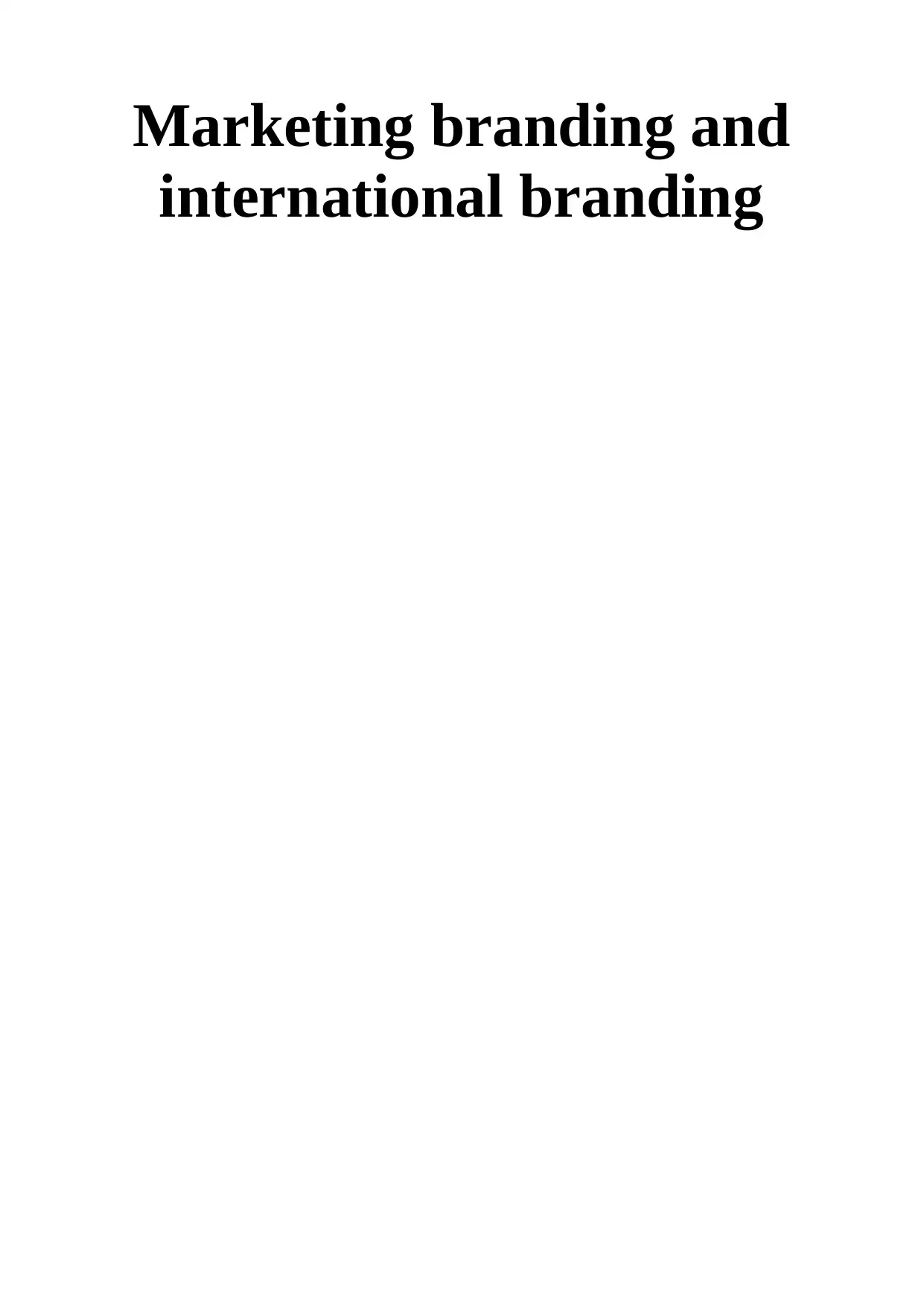
Marketing branding and
international branding
international branding
Paraphrase This Document
Need a fresh take? Get an instant paraphrase of this document with our AI Paraphraser
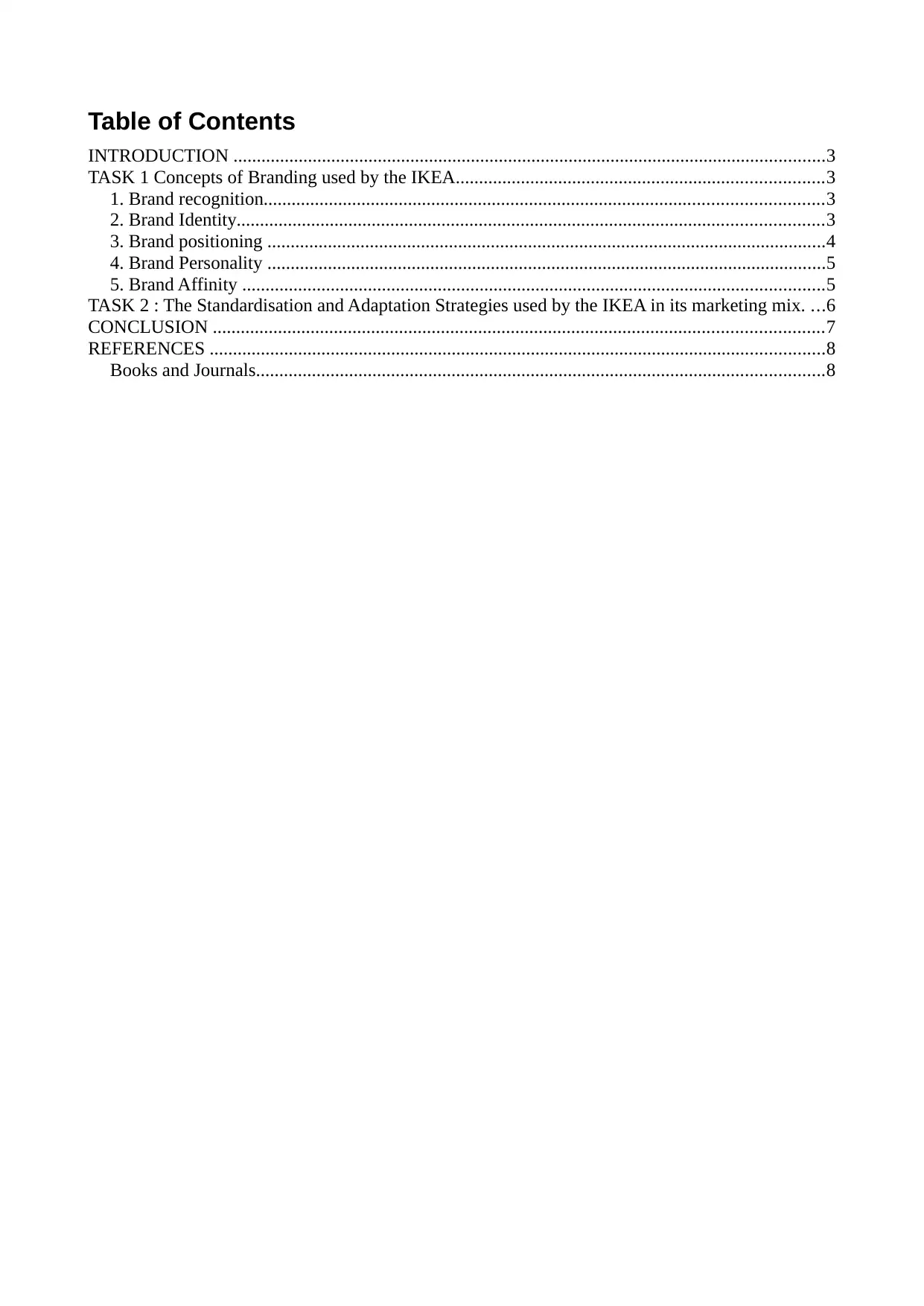
Table of Contents
INTRODUCTION ...............................................................................................................................3
TASK 1 Concepts of Branding used by the IKEA...............................................................................3
1. Brand recognition........................................................................................................................3
2. Brand Identity..............................................................................................................................3
3. Brand positioning ........................................................................................................................4
4. Brand Personality ........................................................................................................................5
5. Brand Affinity .............................................................................................................................5
TASK 2 : The Standardisation and Adaptation Strategies used by the IKEA in its marketing mix. ...6
CONCLUSION ...................................................................................................................................7
REFERENCES ....................................................................................................................................8
Books and Journals..........................................................................................................................8
INTRODUCTION ...............................................................................................................................3
TASK 1 Concepts of Branding used by the IKEA...............................................................................3
1. Brand recognition........................................................................................................................3
2. Brand Identity..............................................................................................................................3
3. Brand positioning ........................................................................................................................4
4. Brand Personality ........................................................................................................................5
5. Brand Affinity .............................................................................................................................5
TASK 2 : The Standardisation and Adaptation Strategies used by the IKEA in its marketing mix. ...6
CONCLUSION ...................................................................................................................................7
REFERENCES ....................................................................................................................................8
Books and Journals..........................................................................................................................8
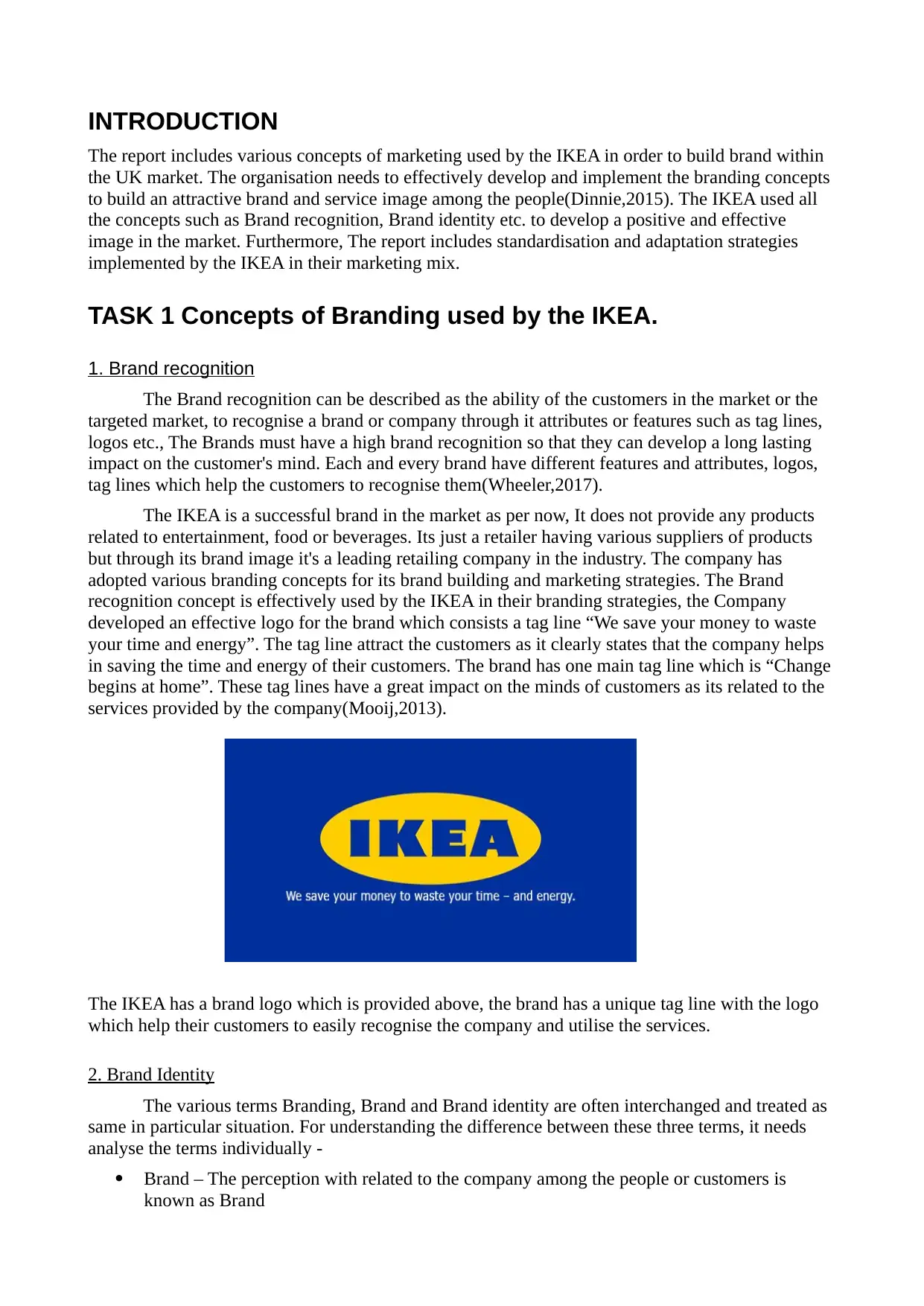
INTRODUCTION
The report includes various concepts of marketing used by the IKEA in order to build brand within
the UK market. The organisation needs to effectively develop and implement the branding concepts
to build an attractive brand and service image among the people(Dinnie,2015). The IKEA used all
the concepts such as Brand recognition, Brand identity etc. to develop a positive and effective
image in the market. Furthermore, The report includes standardisation and adaptation strategies
implemented by the IKEA in their marketing mix.
TASK 1 Concepts of Branding used by the IKEA.
1. Brand recognition
The Brand recognition can be described as the ability of the customers in the market or the
targeted market, to recognise a brand or company through it attributes or features such as tag lines,
logos etc., The Brands must have a high brand recognition so that they can develop a long lasting
impact on the customer's mind. Each and every brand have different features and attributes, logos,
tag lines which help the customers to recognise them(Wheeler,2017).
The IKEA is a successful brand in the market as per now, It does not provide any products
related to entertainment, food or beverages. Its just a retailer having various suppliers of products
but through its brand image it's a leading retailing company in the industry. The company has
adopted various branding concepts for its brand building and marketing strategies. The Brand
recognition concept is effectively used by the IKEA in their branding strategies, the Company
developed an effective logo for the brand which consists a tag line “We save your money to waste
your time and energy”. The tag line attract the customers as it clearly states that the company helps
in saving the time and energy of their customers. The brand has one main tag line which is “Change
begins at home”. These tag lines have a great impact on the minds of customers as its related to the
services provided by the company(Mooij,2013).
The IKEA has a brand logo which is provided above, the brand has a unique tag line with the logo
which help their customers to easily recognise the company and utilise the services.
2. Brand Identity
The various terms Branding, Brand and Brand identity are often interchanged and treated as
same in particular situation. For understanding the difference between these three terms, it needs
analyse the terms individually -
Brand – The perception with related to the company among the people or customers is
known as Brand
The report includes various concepts of marketing used by the IKEA in order to build brand within
the UK market. The organisation needs to effectively develop and implement the branding concepts
to build an attractive brand and service image among the people(Dinnie,2015). The IKEA used all
the concepts such as Brand recognition, Brand identity etc. to develop a positive and effective
image in the market. Furthermore, The report includes standardisation and adaptation strategies
implemented by the IKEA in their marketing mix.
TASK 1 Concepts of Branding used by the IKEA.
1. Brand recognition
The Brand recognition can be described as the ability of the customers in the market or the
targeted market, to recognise a brand or company through it attributes or features such as tag lines,
logos etc., The Brands must have a high brand recognition so that they can develop a long lasting
impact on the customer's mind. Each and every brand have different features and attributes, logos,
tag lines which help the customers to recognise them(Wheeler,2017).
The IKEA is a successful brand in the market as per now, It does not provide any products
related to entertainment, food or beverages. Its just a retailer having various suppliers of products
but through its brand image it's a leading retailing company in the industry. The company has
adopted various branding concepts for its brand building and marketing strategies. The Brand
recognition concept is effectively used by the IKEA in their branding strategies, the Company
developed an effective logo for the brand which consists a tag line “We save your money to waste
your time and energy”. The tag line attract the customers as it clearly states that the company helps
in saving the time and energy of their customers. The brand has one main tag line which is “Change
begins at home”. These tag lines have a great impact on the minds of customers as its related to the
services provided by the company(Mooij,2013).
The IKEA has a brand logo which is provided above, the brand has a unique tag line with the logo
which help their customers to easily recognise the company and utilise the services.
2. Brand Identity
The various terms Branding, Brand and Brand identity are often interchanged and treated as
same in particular situation. For understanding the difference between these three terms, it needs
analyse the terms individually -
Brand – The perception with related to the company among the people or customers is
known as Brand
⊘ This is a preview!⊘
Do you want full access?
Subscribe today to unlock all pages.

Trusted by 1+ million students worldwide
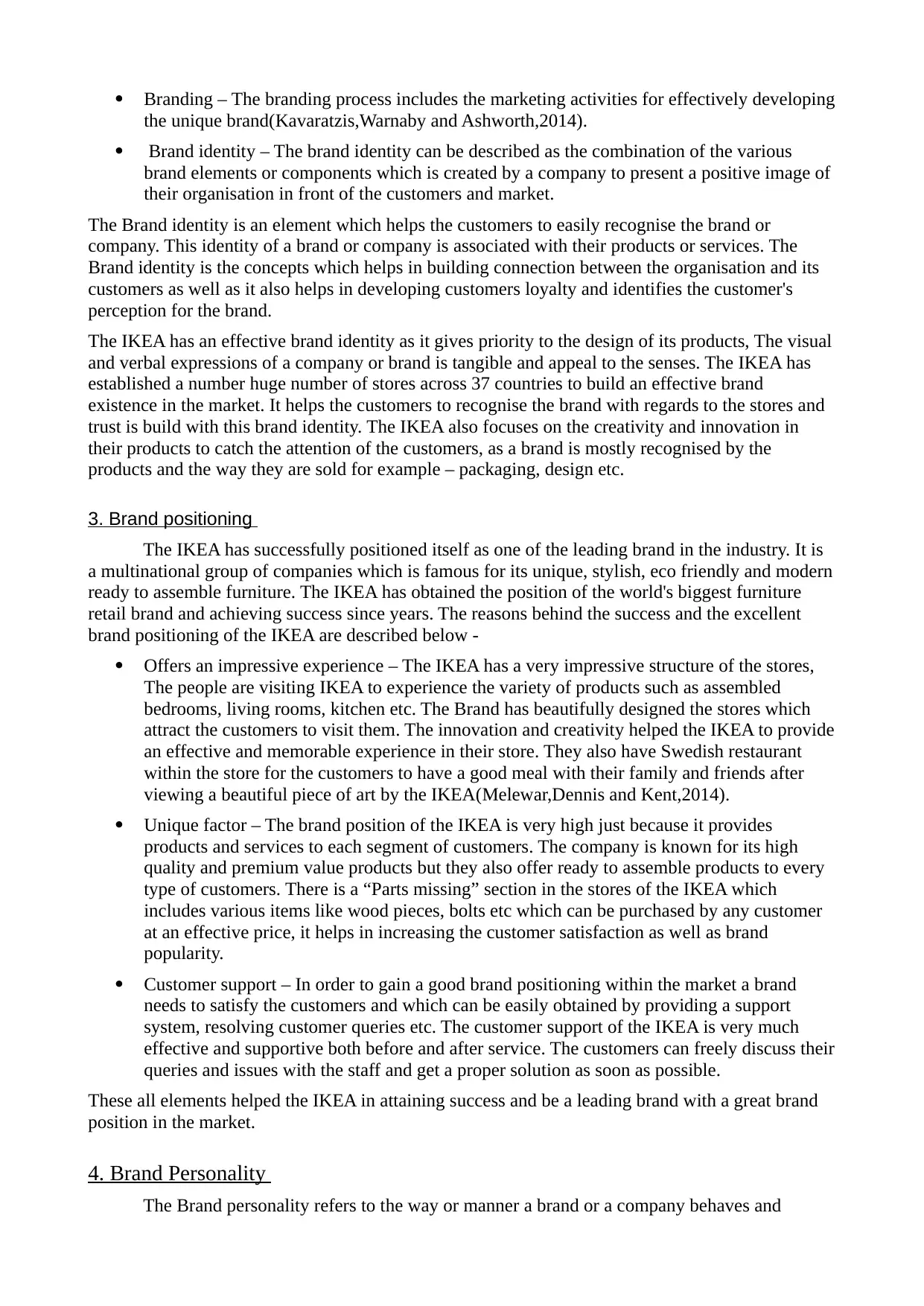
Branding – The branding process includes the marketing activities for effectively developing
the unique brand(Kavaratzis,Warnaby and Ashworth,2014).
Brand identity – The brand identity can be described as the combination of the various
brand elements or components which is created by a company to present a positive image of
their organisation in front of the customers and market.
The Brand identity is an element which helps the customers to easily recognise the brand or
company. This identity of a brand or company is associated with their products or services. The
Brand identity is the concepts which helps in building connection between the organisation and its
customers as well as it also helps in developing customers loyalty and identifies the customer's
perception for the brand.
The IKEA has an effective brand identity as it gives priority to the design of its products, The visual
and verbal expressions of a company or brand is tangible and appeal to the senses. The IKEA has
established a number huge number of stores across 37 countries to build an effective brand
existence in the market. It helps the customers to recognise the brand with regards to the stores and
trust is build with this brand identity. The IKEA also focuses on the creativity and innovation in
their products to catch the attention of the customers, as a brand is mostly recognised by the
products and the way they are sold for example – packaging, design etc.
3. Brand positioning
The IKEA has successfully positioned itself as one of the leading brand in the industry. It is
a multinational group of companies which is famous for its unique, stylish, eco friendly and modern
ready to assemble furniture. The IKEA has obtained the position of the world's biggest furniture
retail brand and achieving success since years. The reasons behind the success and the excellent
brand positioning of the IKEA are described below -
Offers an impressive experience – The IKEA has a very impressive structure of the stores,
The people are visiting IKEA to experience the variety of products such as assembled
bedrooms, living rooms, kitchen etc. The Brand has beautifully designed the stores which
attract the customers to visit them. The innovation and creativity helped the IKEA to provide
an effective and memorable experience in their store. They also have Swedish restaurant
within the store for the customers to have a good meal with their family and friends after
viewing a beautiful piece of art by the IKEA(Melewar,Dennis and Kent,2014).
Unique factor – The brand position of the IKEA is very high just because it provides
products and services to each segment of customers. The company is known for its high
quality and premium value products but they also offer ready to assemble products to every
type of customers. There is a “Parts missing” section in the stores of the IKEA which
includes various items like wood pieces, bolts etc which can be purchased by any customer
at an effective price, it helps in increasing the customer satisfaction as well as brand
popularity.
Customer support – In order to gain a good brand positioning within the market a brand
needs to satisfy the customers and which can be easily obtained by providing a support
system, resolving customer queries etc. The customer support of the IKEA is very much
effective and supportive both before and after service. The customers can freely discuss their
queries and issues with the staff and get a proper solution as soon as possible.
These all elements helped the IKEA in attaining success and be a leading brand with a great brand
position in the market.
4. Brand Personality
The Brand personality refers to the way or manner a brand or a company behaves and
the unique brand(Kavaratzis,Warnaby and Ashworth,2014).
Brand identity – The brand identity can be described as the combination of the various
brand elements or components which is created by a company to present a positive image of
their organisation in front of the customers and market.
The Brand identity is an element which helps the customers to easily recognise the brand or
company. This identity of a brand or company is associated with their products or services. The
Brand identity is the concepts which helps in building connection between the organisation and its
customers as well as it also helps in developing customers loyalty and identifies the customer's
perception for the brand.
The IKEA has an effective brand identity as it gives priority to the design of its products, The visual
and verbal expressions of a company or brand is tangible and appeal to the senses. The IKEA has
established a number huge number of stores across 37 countries to build an effective brand
existence in the market. It helps the customers to recognise the brand with regards to the stores and
trust is build with this brand identity. The IKEA also focuses on the creativity and innovation in
their products to catch the attention of the customers, as a brand is mostly recognised by the
products and the way they are sold for example – packaging, design etc.
3. Brand positioning
The IKEA has successfully positioned itself as one of the leading brand in the industry. It is
a multinational group of companies which is famous for its unique, stylish, eco friendly and modern
ready to assemble furniture. The IKEA has obtained the position of the world's biggest furniture
retail brand and achieving success since years. The reasons behind the success and the excellent
brand positioning of the IKEA are described below -
Offers an impressive experience – The IKEA has a very impressive structure of the stores,
The people are visiting IKEA to experience the variety of products such as assembled
bedrooms, living rooms, kitchen etc. The Brand has beautifully designed the stores which
attract the customers to visit them. The innovation and creativity helped the IKEA to provide
an effective and memorable experience in their store. They also have Swedish restaurant
within the store for the customers to have a good meal with their family and friends after
viewing a beautiful piece of art by the IKEA(Melewar,Dennis and Kent,2014).
Unique factor – The brand position of the IKEA is very high just because it provides
products and services to each segment of customers. The company is known for its high
quality and premium value products but they also offer ready to assemble products to every
type of customers. There is a “Parts missing” section in the stores of the IKEA which
includes various items like wood pieces, bolts etc which can be purchased by any customer
at an effective price, it helps in increasing the customer satisfaction as well as brand
popularity.
Customer support – In order to gain a good brand positioning within the market a brand
needs to satisfy the customers and which can be easily obtained by providing a support
system, resolving customer queries etc. The customer support of the IKEA is very much
effective and supportive both before and after service. The customers can freely discuss their
queries and issues with the staff and get a proper solution as soon as possible.
These all elements helped the IKEA in attaining success and be a leading brand with a great brand
position in the market.
4. Brand Personality
The Brand personality refers to the way or manner a brand or a company behaves and
Paraphrase This Document
Need a fresh take? Get an instant paraphrase of this document with our AI Paraphraser
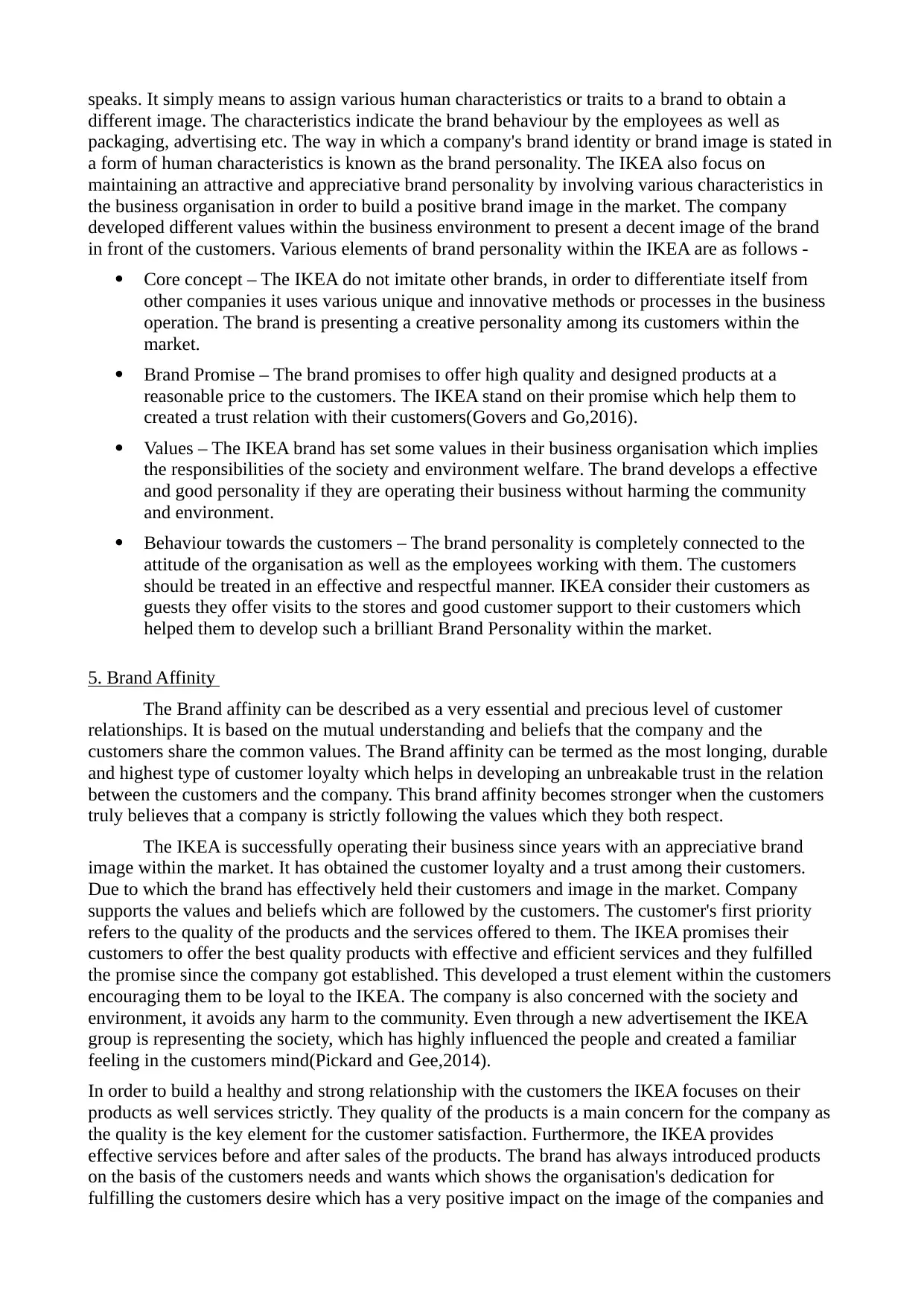
speaks. It simply means to assign various human characteristics or traits to a brand to obtain a
different image. The characteristics indicate the brand behaviour by the employees as well as
packaging, advertising etc. The way in which a company's brand identity or brand image is stated in
a form of human characteristics is known as the brand personality. The IKEA also focus on
maintaining an attractive and appreciative brand personality by involving various characteristics in
the business organisation in order to build a positive brand image in the market. The company
developed different values within the business environment to present a decent image of the brand
in front of the customers. Various elements of brand personality within the IKEA are as follows -
Core concept – The IKEA do not imitate other brands, in order to differentiate itself from
other companies it uses various unique and innovative methods or processes in the business
operation. The brand is presenting a creative personality among its customers within the
market.
Brand Promise – The brand promises to offer high quality and designed products at a
reasonable price to the customers. The IKEA stand on their promise which help them to
created a trust relation with their customers(Govers and Go,2016).
Values – The IKEA brand has set some values in their business organisation which implies
the responsibilities of the society and environment welfare. The brand develops a effective
and good personality if they are operating their business without harming the community
and environment.
Behaviour towards the customers – The brand personality is completely connected to the
attitude of the organisation as well as the employees working with them. The customers
should be treated in an effective and respectful manner. IKEA consider their customers as
guests they offer visits to the stores and good customer support to their customers which
helped them to develop such a brilliant Brand Personality within the market.
5. Brand Affinity
The Brand affinity can be described as a very essential and precious level of customer
relationships. It is based on the mutual understanding and beliefs that the company and the
customers share the common values. The Brand affinity can be termed as the most longing, durable
and highest type of customer loyalty which helps in developing an unbreakable trust in the relation
between the customers and the company. This brand affinity becomes stronger when the customers
truly believes that a company is strictly following the values which they both respect.
The IKEA is successfully operating their business since years with an appreciative brand
image within the market. It has obtained the customer loyalty and a trust among their customers.
Due to which the brand has effectively held their customers and image in the market. Company
supports the values and beliefs which are followed by the customers. The customer's first priority
refers to the quality of the products and the services offered to them. The IKEA promises their
customers to offer the best quality products with effective and efficient services and they fulfilled
the promise since the company got established. This developed a trust element within the customers
encouraging them to be loyal to the IKEA. The company is also concerned with the society and
environment, it avoids any harm to the community. Even through a new advertisement the IKEA
group is representing the society, which has highly influenced the people and created a familiar
feeling in the customers mind(Pickard and Gee,2014).
In order to build a healthy and strong relationship with the customers the IKEA focuses on their
products as well services strictly. They quality of the products is a main concern for the company as
the quality is the key element for the customer satisfaction. Furthermore, the IKEA provides
effective services before and after sales of the products. The brand has always introduced products
on the basis of the customers needs and wants which shows the organisation's dedication for
fulfilling the customers desire which has a very positive impact on the image of the companies and
different image. The characteristics indicate the brand behaviour by the employees as well as
packaging, advertising etc. The way in which a company's brand identity or brand image is stated in
a form of human characteristics is known as the brand personality. The IKEA also focus on
maintaining an attractive and appreciative brand personality by involving various characteristics in
the business organisation in order to build a positive brand image in the market. The company
developed different values within the business environment to present a decent image of the brand
in front of the customers. Various elements of brand personality within the IKEA are as follows -
Core concept – The IKEA do not imitate other brands, in order to differentiate itself from
other companies it uses various unique and innovative methods or processes in the business
operation. The brand is presenting a creative personality among its customers within the
market.
Brand Promise – The brand promises to offer high quality and designed products at a
reasonable price to the customers. The IKEA stand on their promise which help them to
created a trust relation with their customers(Govers and Go,2016).
Values – The IKEA brand has set some values in their business organisation which implies
the responsibilities of the society and environment welfare. The brand develops a effective
and good personality if they are operating their business without harming the community
and environment.
Behaviour towards the customers – The brand personality is completely connected to the
attitude of the organisation as well as the employees working with them. The customers
should be treated in an effective and respectful manner. IKEA consider their customers as
guests they offer visits to the stores and good customer support to their customers which
helped them to develop such a brilliant Brand Personality within the market.
5. Brand Affinity
The Brand affinity can be described as a very essential and precious level of customer
relationships. It is based on the mutual understanding and beliefs that the company and the
customers share the common values. The Brand affinity can be termed as the most longing, durable
and highest type of customer loyalty which helps in developing an unbreakable trust in the relation
between the customers and the company. This brand affinity becomes stronger when the customers
truly believes that a company is strictly following the values which they both respect.
The IKEA is successfully operating their business since years with an appreciative brand
image within the market. It has obtained the customer loyalty and a trust among their customers.
Due to which the brand has effectively held their customers and image in the market. Company
supports the values and beliefs which are followed by the customers. The customer's first priority
refers to the quality of the products and the services offered to them. The IKEA promises their
customers to offer the best quality products with effective and efficient services and they fulfilled
the promise since the company got established. This developed a trust element within the customers
encouraging them to be loyal to the IKEA. The company is also concerned with the society and
environment, it avoids any harm to the community. Even through a new advertisement the IKEA
group is representing the society, which has highly influenced the people and created a familiar
feeling in the customers mind(Pickard and Gee,2014).
In order to build a healthy and strong relationship with the customers the IKEA focuses on their
products as well services strictly. They quality of the products is a main concern for the company as
the quality is the key element for the customer satisfaction. Furthermore, the IKEA provides
effective services before and after sales of the products. The brand has always introduced products
on the basis of the customers needs and wants which shows the organisation's dedication for
fulfilling the customers desire which has a very positive impact on the image of the companies and
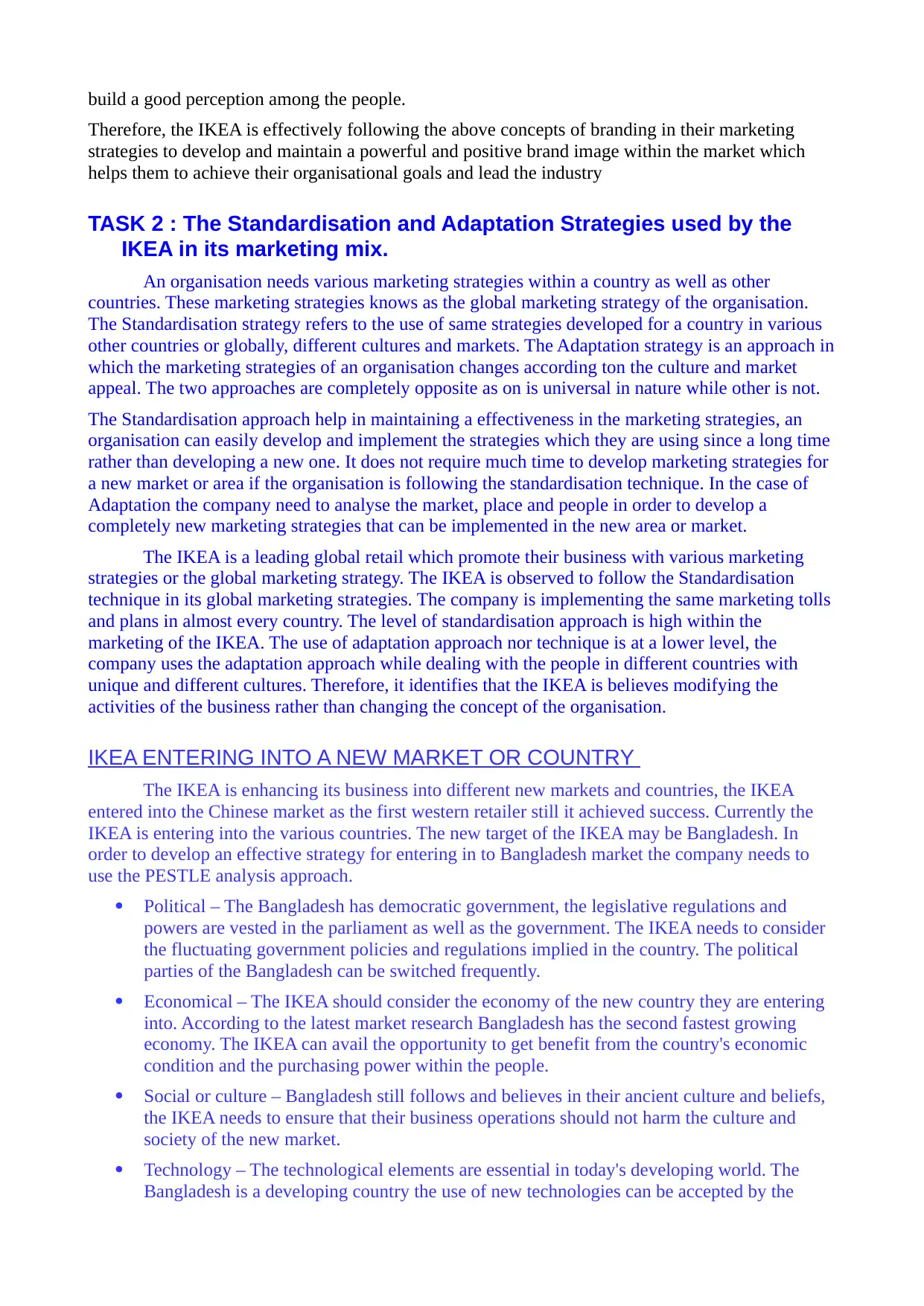
build a good perception among the people.
Therefore, the IKEA is effectively following the above concepts of branding in their marketing
strategies to develop and maintain a powerful and positive brand image within the market which
helps them to achieve their organisational goals and lead the industry
TASK 2 : The Standardisation and Adaptation Strategies used by the
IKEA in its marketing mix.
An organisation needs various marketing strategies within a country as well as other
countries. These marketing strategies knows as the global marketing strategy of the organisation.
The Standardisation strategy refers to the use of same strategies developed for a country in various
other countries or globally, different cultures and markets. The Adaptation strategy is an approach in
which the marketing strategies of an organisation changes according ton the culture and market
appeal. The two approaches are completely opposite as on is universal in nature while other is not.
The Standardisation approach help in maintaining a effectiveness in the marketing strategies, an
organisation can easily develop and implement the strategies which they are using since a long time
rather than developing a new one. It does not require much time to develop marketing strategies for
a new market or area if the organisation is following the standardisation technique. In the case of
Adaptation the company need to analyse the market, place and people in order to develop a
completely new marketing strategies that can be implemented in the new area or market.
The IKEA is a leading global retail which promote their business with various marketing
strategies or the global marketing strategy. The IKEA is observed to follow the Standardisation
technique in its global marketing strategies. The company is implementing the same marketing tolls
and plans in almost every country. The level of standardisation approach is high within the
marketing of the IKEA. The use of adaptation approach nor technique is at a lower level, the
company uses the adaptation approach while dealing with the people in different countries with
unique and different cultures. Therefore, it identifies that the IKEA is believes modifying the
activities of the business rather than changing the concept of the organisation.
IKEA ENTERING INTO A NEW MARKET OR COUNTRY
The IKEA is enhancing its business into different new markets and countries, the IKEA
entered into the Chinese market as the first western retailer still it achieved success. Currently the
IKEA is entering into the various countries. The new target of the IKEA may be Bangladesh. In
order to develop an effective strategy for entering in to Bangladesh market the company needs to
use the PESTLE analysis approach.
Political – The Bangladesh has democratic government, the legislative regulations and
powers are vested in the parliament as well as the government. The IKEA needs to consider
the fluctuating government policies and regulations implied in the country. The political
parties of the Bangladesh can be switched frequently.
Economical – The IKEA should consider the economy of the new country they are entering
into. According to the latest market research Bangladesh has the second fastest growing
economy. The IKEA can avail the opportunity to get benefit from the country's economic
condition and the purchasing power within the people.
Social or culture – Bangladesh still follows and believes in their ancient culture and beliefs,
the IKEA needs to ensure that their business operations should not harm the culture and
society of the new market.
Technology – The technological elements are essential in today's developing world. The
Bangladesh is a developing country the use of new technologies can be accepted by the
Therefore, the IKEA is effectively following the above concepts of branding in their marketing
strategies to develop and maintain a powerful and positive brand image within the market which
helps them to achieve their organisational goals and lead the industry
TASK 2 : The Standardisation and Adaptation Strategies used by the
IKEA in its marketing mix.
An organisation needs various marketing strategies within a country as well as other
countries. These marketing strategies knows as the global marketing strategy of the organisation.
The Standardisation strategy refers to the use of same strategies developed for a country in various
other countries or globally, different cultures and markets. The Adaptation strategy is an approach in
which the marketing strategies of an organisation changes according ton the culture and market
appeal. The two approaches are completely opposite as on is universal in nature while other is not.
The Standardisation approach help in maintaining a effectiveness in the marketing strategies, an
organisation can easily develop and implement the strategies which they are using since a long time
rather than developing a new one. It does not require much time to develop marketing strategies for
a new market or area if the organisation is following the standardisation technique. In the case of
Adaptation the company need to analyse the market, place and people in order to develop a
completely new marketing strategies that can be implemented in the new area or market.
The IKEA is a leading global retail which promote their business with various marketing
strategies or the global marketing strategy. The IKEA is observed to follow the Standardisation
technique in its global marketing strategies. The company is implementing the same marketing tolls
and plans in almost every country. The level of standardisation approach is high within the
marketing of the IKEA. The use of adaptation approach nor technique is at a lower level, the
company uses the adaptation approach while dealing with the people in different countries with
unique and different cultures. Therefore, it identifies that the IKEA is believes modifying the
activities of the business rather than changing the concept of the organisation.
IKEA ENTERING INTO A NEW MARKET OR COUNTRY
The IKEA is enhancing its business into different new markets and countries, the IKEA
entered into the Chinese market as the first western retailer still it achieved success. Currently the
IKEA is entering into the various countries. The new target of the IKEA may be Bangladesh. In
order to develop an effective strategy for entering in to Bangladesh market the company needs to
use the PESTLE analysis approach.
Political – The Bangladesh has democratic government, the legislative regulations and
powers are vested in the parliament as well as the government. The IKEA needs to consider
the fluctuating government policies and regulations implied in the country. The political
parties of the Bangladesh can be switched frequently.
Economical – The IKEA should consider the economy of the new country they are entering
into. According to the latest market research Bangladesh has the second fastest growing
economy. The IKEA can avail the opportunity to get benefit from the country's economic
condition and the purchasing power within the people.
Social or culture – Bangladesh still follows and believes in their ancient culture and beliefs,
the IKEA needs to ensure that their business operations should not harm the culture and
society of the new market.
Technology – The technological elements are essential in today's developing world. The
Bangladesh is a developing country the use of new technologies can be accepted by the
⊘ This is a preview!⊘
Do you want full access?
Subscribe today to unlock all pages.

Trusted by 1+ million students worldwide
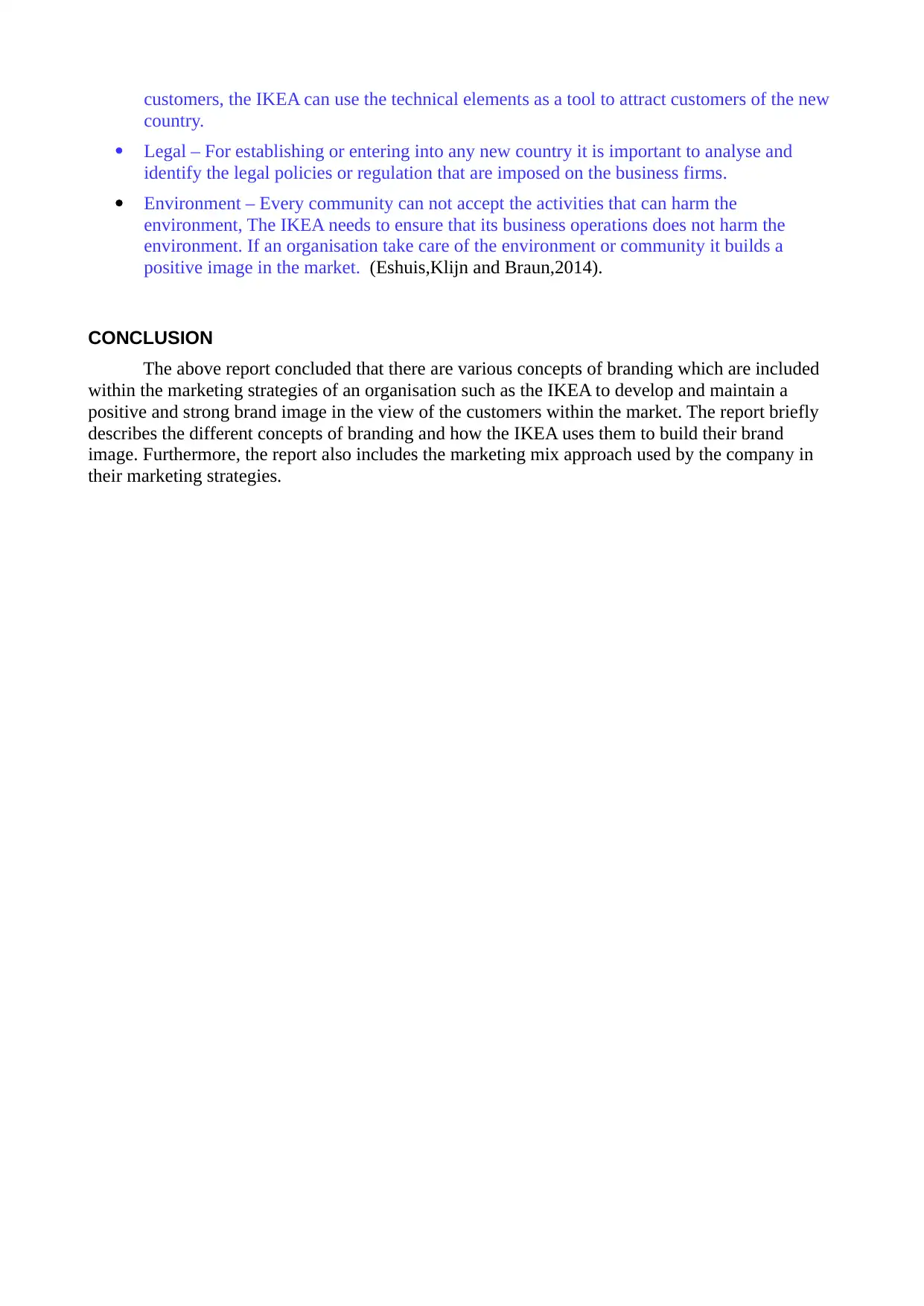
customers, the IKEA can use the technical elements as a tool to attract customers of the new
country.
Legal – For establishing or entering into any new country it is important to analyse and
identify the legal policies or regulation that are imposed on the business firms.
Environment – Every community can not accept the activities that can harm the
environment, The IKEA needs to ensure that its business operations does not harm the
environment. If an organisation take care of the environment or community it builds a
positive image in the market. (Eshuis,Klijn and Braun,2014).
CONCLUSION
The above report concluded that there are various concepts of branding which are included
within the marketing strategies of an organisation such as the IKEA to develop and maintain a
positive and strong brand image in the view of the customers within the market. The report briefly
describes the different concepts of branding and how the IKEA uses them to build their brand
image. Furthermore, the report also includes the marketing mix approach used by the company in
their marketing strategies.
country.
Legal – For establishing or entering into any new country it is important to analyse and
identify the legal policies or regulation that are imposed on the business firms.
Environment – Every community can not accept the activities that can harm the
environment, The IKEA needs to ensure that its business operations does not harm the
environment. If an organisation take care of the environment or community it builds a
positive image in the market. (Eshuis,Klijn and Braun,2014).
CONCLUSION
The above report concluded that there are various concepts of branding which are included
within the marketing strategies of an organisation such as the IKEA to develop and maintain a
positive and strong brand image in the view of the customers within the market. The report briefly
describes the different concepts of branding and how the IKEA uses them to build their brand
image. Furthermore, the report also includes the marketing mix approach used by the company in
their marketing strategies.
Paraphrase This Document
Need a fresh take? Get an instant paraphrase of this document with our AI Paraphraser
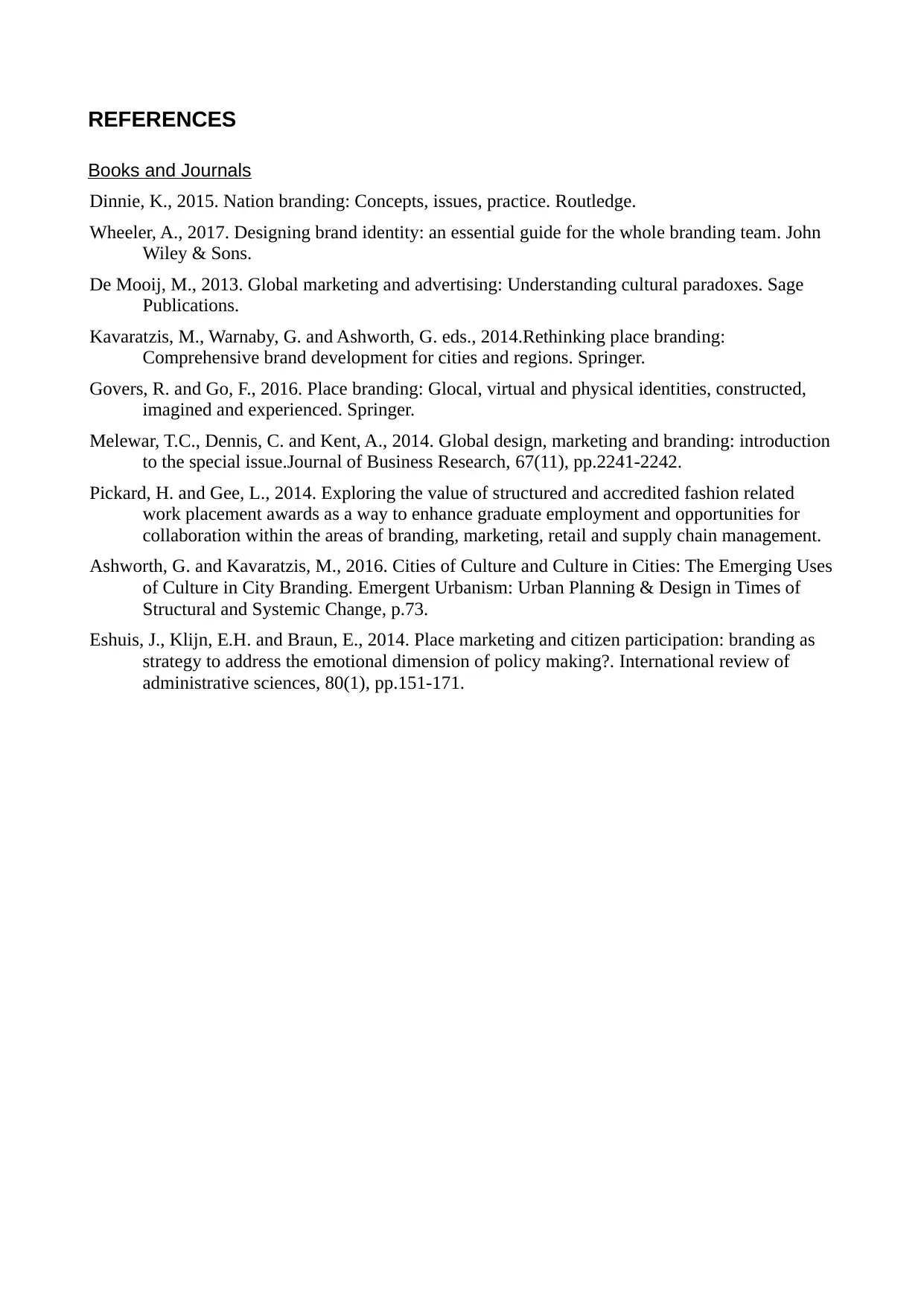
REFERENCES
Books and Journals
Dinnie, K., 2015. Nation branding: Concepts, issues, practice. Routledge.
Wheeler, A., 2017. Designing brand identity: an essential guide for the whole branding team. John
Wiley & Sons.
De Mooij, M., 2013. Global marketing and advertising: Understanding cultural paradoxes. Sage
Publications.
Kavaratzis, M., Warnaby, G. and Ashworth, G. eds., 2014.Rethinking place branding:
Comprehensive brand development for cities and regions. Springer.
Govers, R. and Go, F., 2016. Place branding: Glocal, virtual and physical identities, constructed,
imagined and experienced. Springer.
Melewar, T.C., Dennis, C. and Kent, A., 2014. Global design, marketing and branding: introduction
to the special issue.Journal of Business Research, 67(11), pp.2241-2242.
Pickard, H. and Gee, L., 2014. Exploring the value of structured and accredited fashion related
work placement awards as a way to enhance graduate employment and opportunities for
collaboration within the areas of branding, marketing, retail and supply chain management.
Ashworth, G. and Kavaratzis, M., 2016. Cities of Culture and Culture in Cities: The Emerging Uses
of Culture in City Branding. Emergent Urbanism: Urban Planning & Design in Times of
Structural and Systemic Change, p.73.
Eshuis, J., Klijn, E.H. and Braun, E., 2014. Place marketing and citizen participation: branding as
strategy to address the emotional dimension of policy making?. International review of
administrative sciences, 80(1), pp.151-171.
Books and Journals
Dinnie, K., 2015. Nation branding: Concepts, issues, practice. Routledge.
Wheeler, A., 2017. Designing brand identity: an essential guide for the whole branding team. John
Wiley & Sons.
De Mooij, M., 2013. Global marketing and advertising: Understanding cultural paradoxes. Sage
Publications.
Kavaratzis, M., Warnaby, G. and Ashworth, G. eds., 2014.Rethinking place branding:
Comprehensive brand development for cities and regions. Springer.
Govers, R. and Go, F., 2016. Place branding: Glocal, virtual and physical identities, constructed,
imagined and experienced. Springer.
Melewar, T.C., Dennis, C. and Kent, A., 2014. Global design, marketing and branding: introduction
to the special issue.Journal of Business Research, 67(11), pp.2241-2242.
Pickard, H. and Gee, L., 2014. Exploring the value of structured and accredited fashion related
work placement awards as a way to enhance graduate employment and opportunities for
collaboration within the areas of branding, marketing, retail and supply chain management.
Ashworth, G. and Kavaratzis, M., 2016. Cities of Culture and Culture in Cities: The Emerging Uses
of Culture in City Branding. Emergent Urbanism: Urban Planning & Design in Times of
Structural and Systemic Change, p.73.
Eshuis, J., Klijn, E.H. and Braun, E., 2014. Place marketing and citizen participation: branding as
strategy to address the emotional dimension of policy making?. International review of
administrative sciences, 80(1), pp.151-171.
1 out of 8
Related Documents
Your All-in-One AI-Powered Toolkit for Academic Success.
+13062052269
info@desklib.com
Available 24*7 on WhatsApp / Email
![[object Object]](/_next/static/media/star-bottom.7253800d.svg)
Unlock your academic potential
Copyright © 2020–2025 A2Z Services. All Rights Reserved. Developed and managed by ZUCOL.





